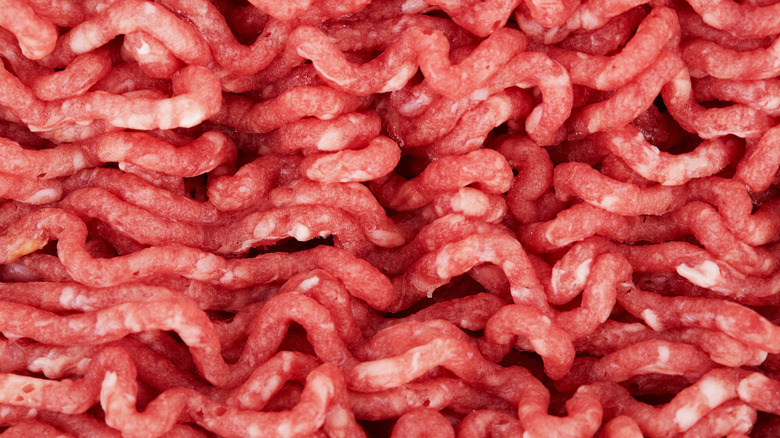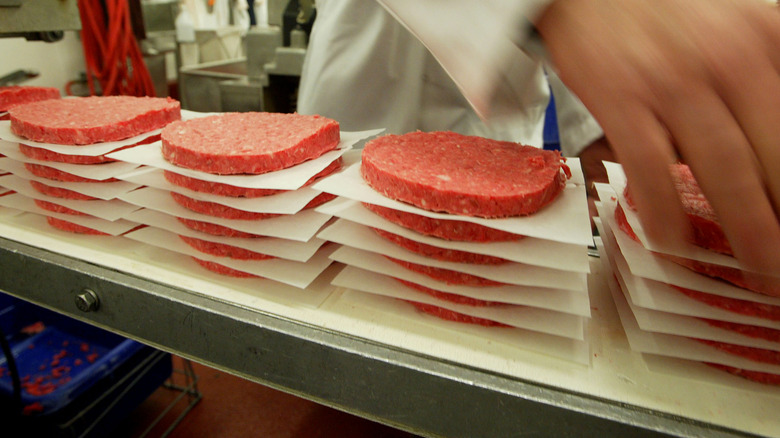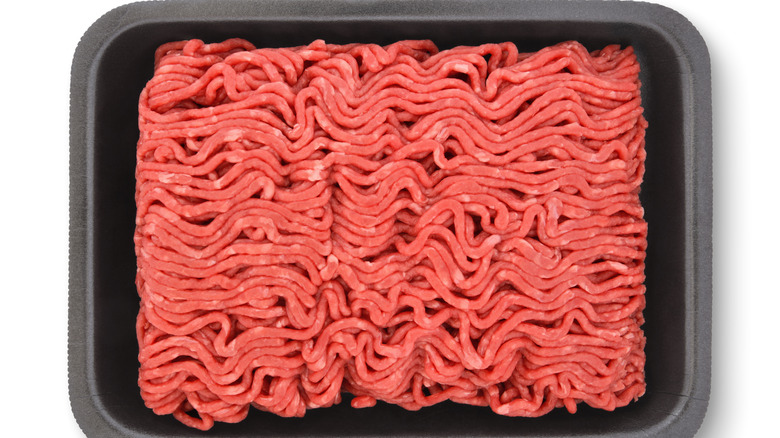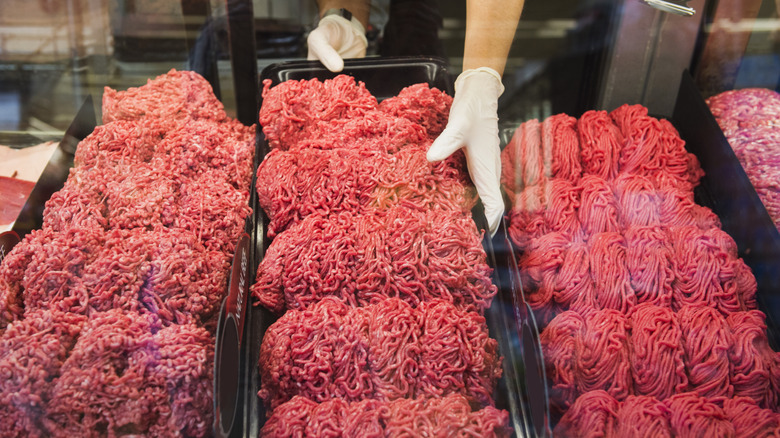8 Of The Biggest Ground Beef Recalls In American History
We Americans are crazy about ground beef. We eat on average three hamburgers a week, which comes out to around 50 billion burgers a year. And when we're not eating burgers, chances are we're enjoying a classic meatloaf, old-school beef tacos, or a hearty, beefy Bolognese sauce over pasta, both at restaurants and at home. Cooks love having ground beef on hand because it's versatile, it's relatively affordable compared to other beef cuts, and most importantly, almost everyone likes it.
But dangers lurk beneath its wholesome image. While serious carnivores crave rare, juicy burgers and even raw ground beef dishes such as steak tartare, the U.S. Department of Agriculture (USDA) recommends cooking ground beef thoroughly, since it's more susceptible to pathogen contamination that other cuts. This is because the increased surface area on ground meat exposes more of the meat to any pathogens that may have been on its surface before grinding. While regular USDA inspection of meat and meat-producing facilities ensures almost all ground beef we eat is safe, on occasion, contaminated meat makes its way to the public –- and recalls are the next step to restore public safety. Here are some of the biggest ground beef recalls that have occurred in the U.S. — and their consequences for burger lovers.
2008: Hallmark /Westland Meat Packing Co.
In 2008, America's burger lovers dodged a bullet: California-based Hallmark/Westland Meat Packing Company recalled 143 million pounds of beef, some of which had been bought for school lunch programs. At the time, it was the biggest beef recall in American history. Thankfully, no illnesses were reported from the facility's meat. The recall was prompted by inspection violations rather than any specific contamination and involved meat produced by the company since February 2006. It came on the heels of several other high-profile cases of beef contamination: in 2007, cases of E. coli-contaminated beef spiked, sparking 20 recalls.
The cause of the Hallmark/Westland recall was appalling: In January 2008, the Humane Society of the United States released an undercover video taken at the facility that showed sick animals, many unable to walk, being kicked, dragged, blasted with hoses, and carried with forklifts. Besides the obvious cruelty of these actions, they also posed a risk to meat-eaters: The U.S. forbids the sale and consumption of non-ambulatory cattle, which have a higher chance of carrying mad cow disease. The USDA suspended inspections –- and thus, operations –- at the plant until the situation was corrected, and a trade organization, the American Association of Bovine Practitioners, condemned the behaviors seen in the video. "Our profession strongly promotes proper care and handling practices for livestock, and abuses seen in this situation cannot be tolerated," the AABP said in a press statement.
2014: Rancho Feeding Corporation
Regular federal inspection of meat and meat-processing facilities is the reason we take meat safety for granted: When we pick up a fresh-looking package of ground beef or other meat, we assume without question that we'll be able to eat it without getting sick. The system only works, however, when meat processors listen to and follow the inspectors' directives. But between 2012 and 2014, one company –- Rancho Feeding Corporation –- chose to defy the USDA and sell beef that the federal agency's inspectors had labeled unfit for consumption.
According to federal prosecutors, this was no innocent oversight. They asserted that one of Rancho's co-owners ordered employees to carve the "USDA Condemned" stamps off cattle carcasses that had failed inspection and continue to process and sell them. Prosecutors also asserted that Rancho intentionally slaughtered and processed cattle with cancer eye, which rendered them unfit for human consumption. According to these officials, Rancho staff tried to sneak these diseased carcasses past inspectors by switching out their heads with heads from healthy cattle. Fortunately, no illnesses were linked to this meat, but things didn't end well for Rancho, which was forced to recall 8.7 million pounds of beef products and soon after, ceased operations.
1997: Hudson Foods
A difficult lesson most adults learn from hard experience is that when you screw up, your best move is to fess up quickly and fix the problem. Trying to cover up your error is a bad move, and even worse is doubling down and insisting you did nothing wrong when caught. Unfortunately, the senior management at Hudson Foods Inc. never got this memo. In 1997, the company recalled 25 million pounds of ground beef, some of it earmarked for chains including Burger King, Boston Market, and Walmart, due to an outbreak of E. coli in Colorado linked to meat from a Hudson facility in Nebraska.
While the recall was technically voluntary, the USDA made it clear it would shut the plant down if the company failed to comply. Inspectors found problematic quality control and record-keeping at the plant, which could have resulted in old meat being mixed into new batches. Hudson management initially claimed that the contamination came from one of the slaughterhouses that provided the meat, not from its own facilities. Company officials later told the USDA that the source of contamination was a single lot –- but the USDA determined this lot had never been shipped to Colorado, so it could not have caused the outbreak. This fib landed Hudson Foods and two of its executives facing a federal indictment for providing false information to the USDA. The Hudson plant involved in the recall closed and was sold to another company.
2009: Beef Packers Inc.
For most people, food poisoning means a few days of utter misery. But for certain populations, including children, older adults, and people who have compromised immune systems, it can be downright scary, if not deadly. And scarier still are drug-resistant strains of foodborne bacteria: If one of these hits you, you'll likely have to just ride it out and hope for the best.
In 2009, about 40 people across nine Western states experienced this nightmare, contracting a drug-resistant strain of salmonella Newport, which can cause a week or more of fever, chills, abdominal cramps, vomiting, and headaches. Their illness was traced back to ground beef produced by California-based Beef Packers, which recalled 826,000 pounds of ground meat in response. Identifying the affected meat, however, was tricky for consumers: Beef Packers had shipped the meat to multiple distribution centers, where it was repackaged and rebranded for delivery to retailers. This meant the tainted meat appeared under multiple brand names. Thus, the USDA urged consumers to do their due diligence and ask store management if their meat was affected.
2007: Topps Meat Company
Smart (or lucky) businesses can overcome some pretty serious reputational damage and continue to thrive –- consider all the airlines that continue to fly even after high-profile crashes. But sometimes, just one big screwup is enough to destroy an established business. This was the case with New Jersey-based Topps Meat Company, which recalled 21.7 million pounds of ground beef in 2007 following an E. coli outbreak that sickened over 30 people in multiple states.
The recall not only put a halt to Topps' ground meat production but also revealed irregularities in its processes for other meat cuts, such as steaks. This led the USDA to threaten to stop all meat production at Topps. The company also faced multiple lawsuits from people sickened by the tainted beef. In addition, unlike many other food producers, Topps had no revenue source other than meat processing, and after all the high-profile illnesses and lawsuits, Topps knew its existing customers would almost certainly choose to get their burgers elsewhere. This cascade of falling dominoes was more than the company could sustain, and only a week after the recall, Topps announced it was closing shop. On one of the company's final days, employees held a barbecue at Topps headquarters, where they grilled and ate the last of the burgers -– cooked safely to well done, of course, one of the many tips when cooking ground beef.
2009: JBS Swift Beef Company
Tracking down tainted ground beef isn't as easy as you might think. Some of the most common pathogens that thrive in ground beef, such as E. coli and salmonella, have no effect on the taste, smell, or appearance of ground meat. Thus, a tainted burger will look and taste just like a safe one –- and you'll have no way of knowing you're in trouble until the bacteria settle into your system and start to do their work.
This means that tracking down the source of an outbreak -– or even realizing that cases of food poisoning in different locations may be related –- can require a bit of detective work. For instance, a 2009 E. coli outbreak that sickened around 23 people in nine states was traced to ground beef from JBS Swift Beef Company. Health officials in Michigan identified a specific DNA fingerprint in the E. coli bacteria found in an open package of beef in a patient's home, and officials in other states discovered the same strain in other ill patients, along with patient reports of having eaten rare ground beef before falling ill. This discovery led JBS Swift Beef to recall 41,280 pounds of ground beef, and four days later, it recalled an additional 380,000 pounds of other beef cuts.
2023: American Foods Group
When it comes to food safety, a good motto is better safe than sorry. A case in point is the 2023 recall of 58,281 pounds of ground beef produced by Wisconsin-based American Foods Group (doing business as Green Bay Dressed Beef LLC). While no illnesses were linked to the beef, the potential for a deadly outbreak was there: A meat sample examined by a state inspector found it tested positive for shiga-toxin-producing E. coli 0103, a strain that's more difficult to detect and identify than more common strains. The state inspector notified the USDA, which triggered the recall.
The recalled products were 80-pound boxes of 10-pound plastic-wrapped chubs of ground beef –- they were intended to be sold to retailers, not directly to consumers. These packages were to be sent to distributors in Georgia, Michigan, and Ohio. The USDA warned distributors to look out for these products and not process them further or sell them.
2022: Tyson Foods
Most ground beef recalls are due to invisible dangers, such as E. coli or salmonella. But while it's easier to keep visible contaminants out of meat –- and easier to spot and remove any that make their way in –- on occasion, visibly contaminated meat makes its way to consumers. In 2022, Tyson Foods began to receive complaints from shoppers, who had found shards of mirror-like material in the company's ground beef. While no one reported any injuries or illnesses from this contamination, Tyson took their complaints seriously. The company notified the USDA and launched a recall of 93,679 pounds of ground beef.
Fortunately, Tyson was able to narrow down the problem to meat produced on a single day at a single factory in Amarillo, Texas. Moreover, all this meat was destined for a single customer, the Texas supermarket chain H-E-B. The USDA urged consumers who may have purchased the affected meat to check their refrigerators and freezers for the products and discard or return them.








